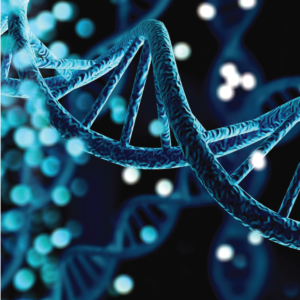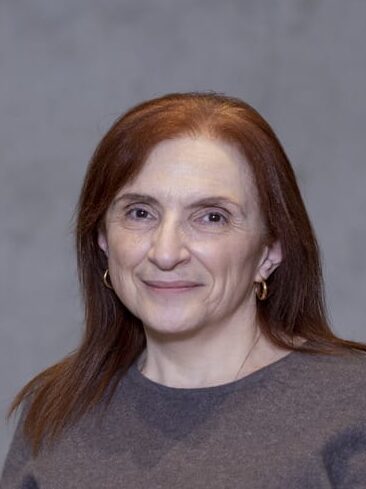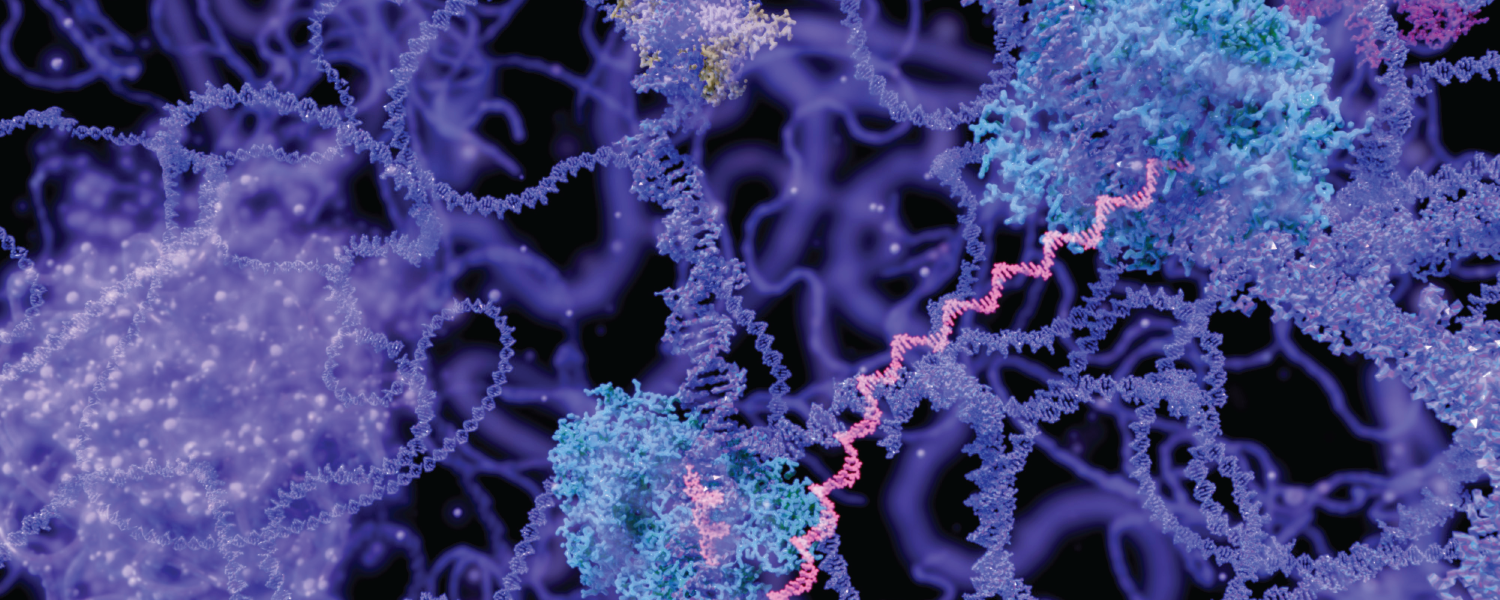Fondufe-Mittendorf Laboratory
 Epigenetic Regulation and Environmental Impacts
Epigenetic Regulation and Environmental Impacts
The Fondufe-Mittendorf Lab focuses on mechanisms by which chromatin and the epigenome are modulated during normal growth and in response to environmental cues. Our lab uses multifaceted approaches at the interface of biology, toxicology, bioinformatics and medicine to study how and when the modulation of chromatin and epigenomics goes awry, leading to changes in gene expression that drives disease pathology. Our findings will not only provide a basic mechanistic insight into principles that govern gene regulation but also will inform on gene expression dysregulation in disease pathology and ultimately drug discovery.
Our Impact
We’re raising thousands to save millions.
We’re turning hope into action for the millions of people around the world affected by diseases like cancer and Parkinson’s. Find out how you can help us make a difference.
- 122 peer-reviewed papers published in 2024, 63 of which were in high-impact journals
- 15 VAI-SU2C Epigenetics Dream Team clinical trials launched to date
- 10 clinical trials co-funded by VAI & Cure Parkinson's (out of 41 total International Linked Clinical Trials Program trials)
Yvonne Fondufe-Mittendorf, Ph.D.
Interim Chair, Department of Cell Biology; Professor, Department of Epigenetics
Areas of Expertise
Epigenetics, chromatin biology, environmental impacts, cancer, nucleosome structure, toxicology, disease pathology, bioinformatics
Biography
Dr. Yvonne Fondufe-Mittendorf is an epigenetics expert with an interest in how environmental factors impact the epigenome and spur cancer development. She earned her bachelor’s and master’s degrees from University of Ibadan, Nigeria, and her Ph.D. in molecular genetics from Georg-August Universitaet, Germany. Following postdoctoral fellowships in the Jovin Lab at Max Planck Institute for Biophysical Chemistry, Germany, and the Widom Lab at Northwestern University, Dr. Fondufe-Mittendorf joined University of Kentucky as an assistant professor. She was promoted to full professor in 2021. She joined Van Andel Institute’s Department of Epigenetics as a professor in 2022. Her research blends epigenetics, toxicology, bioinformatics and medicine to understand how interactions with the environment, such as exposure to toxicants like arsenic, drive gene dysregulation and disease pathology. She and her groundbreaking research have been highlighted by American Society for Biochemistry and Molecular Biology, PLoS One Everyone, Onclive and the National Institute of Environmental Health Sciences’ Environmental Factor. She has earned multiple awards for her research and mentorship, including the National Institute of Health’s IDeA Thomas Maciag Award, University of Kentucky Research Professorship and recognition from University of Kentucky’s Chellgreen Center.
Professional Memberships
- American Society of Biochemistry and Molecular Biology
- Biophysical Society
- Epigenetics Society
- Society of Toxicology
- Epigenetics and Mutagenesis Society
- Editorial board, Scientific Reports
SELECTED PUBLICATIONS
View Dr. Fondufe-Mittendorf’s NCBI bibliography here.
Dhahri H, Fondufe-Mittendorf Y. 2024. Exploring the interplay between PARP1 and circRNA biogenesis and function. Wiley Interdiscip Rev RNA.
Melikishvili M, Fried MG, Fondufe-Mittendorf Y. 2024. Cooperative nucleic acid binding by Poly ADP-ribose polymerase 1. Sci Rep. 14(1):7530.
Rea M, Kimmerer G, Mittendorf S, Xiong X, Meghan G, Chandler D, Saintilnord W, Blackburn J, Gao T, Fondufe-Mittendorf Y. 2024. A dynamic model of inorganic arsenic-induced carcinogenesis reveals an epigenetic mechanism for epithelial-mesenchymal plasticity. Environ Pollut 347:123586.
Dhahri H, Matveeva E, Fondufe-Mittendorf Y. 2023. Approach to measuring the effect of PARP1 on RNA polymerase II elongation rates. Methods Mol Biol. 2609:315–328.
Eleazer R, De Silva K, Andreeva K, Jenkins Z, Osmani N, Rouchka EC, Fondufe-Mittendorf Y. 2023. PARP1 regulates circular RNA biogenesis though control of transcriptional dynamics. Cells 12(8):1160.
George S, Cassidy RN, Saintilnord WN, Fondufe-Mittendorf, Y. 2023. Epigenomic reprogramming in iAs-mediated carcinogenesis. Adv Pharmacol 96:319–365.
Matveeva EA, Dhahri H, Fondufe-Mittendorf Y. 2022. PARP1’s involvement in RNA polymerase ii elongation: Pausing and releasing regulation through the integrator and super elongation complex. Cells 11(20):3202.
Saintilnord WN, Tenlep SYN, Preston JD, Duregon E, DeRouchey JE, Unrine JM, de Cabo R, Pearson KJ, Fondufe-Mittendorf YN. 2021. Chronic exposure to cadmium induces differential methylation in mice spermatozoa. Tox Sci 180(2):262–276.
Leachman J, Rea M, Cohn D, Xiu X, Dalmasso C, Fondufe-Mittendorf YN. Loria A. 2020. Mice exposed to early life stress display sex-specific upregulation of leptin gene expression in adipose tissue. Am J Physiol Endocrinol Metab 319(5):E852–E862.
Rebekah E, Fondufe-Mittendorf YN. 2020. The multifaceted role of PARP1 in RNA biogenesis. WIRES RNA.
von Walden F, Rea M, Mobley CB, Fondufe-Mittendorf YN, McCarthy JJ, Peterson CA, Murach KA. 2020. The myonuclear DNA methylome in response to an acute hypertrophic stimulus. Epigenetics 15(11):1151–1162.
Zhang C, Fondufe-Mittendorf YN, Wang C, Chen J, Cheng Q, Zhou D, Zheng Y, Geiger H, Liang Y. 2019. Latexin regulation by HMGB2 is required for hematopoietic stem cell maintenance. Haematologica 105(3).
Convertini P, Todisco S, De Santis F, Pappalardo I, Iacobazzi D, Castiglione Morelli MA, Fondufe-Mittendorf YN, Martelli G, Palmieri F, Infantino V. 2019. Transcriptional regulation factors of the human mitochondrial aspartate/glutamate carrier gene, isoform 2 (SLC25A13): USF1 as basal factor and FOXA2 as activator in liver cells. Int J Mol Sci 20(8):1888.
Matveeva EA, Mathbout LF, Fondufe-Mittendorf YN. 2019. PARP1 is a versatile factor in the regulation of mRNA stability and decay. Sci Rep 9:3722.
Matveeva EA, Al-Tinawi QMH, Rouchka EC, Fondufe-Mittendorf YN. 2019. Coupling of PARP1-mediated chromatin structural changes to transcriptional RNA polymerase II elongation and cotranscriptional splicing. Epigenetics Chromatin 12(1):15.
Melikishvili M, Charliker J, Rouchka E, Fondufe-Mittendorf YN. 2017. Transcriptome-wide Identification of the RNA-binding profile of the chromatin-associated protein PARP1, reveals functions in RNA biogenesis. Nat Cell Disc 3:17043.
Rea M, Gripshover T, Fondufe-Mittendorf YN. 2017. Selective Inhibition of CTCF binding by iAs directs TET-mediated reprogramming of 5-hydroxymethylation patterns in iAs transformed cells. Toxicol Appl Pharmacol 338:124–133.
Melikishvili M, Matveeva E, Fondufe-Mittendorf YN. 2017. Methodology to identify Poly-ADPRibose Polymerase 1 (PARP1)-mRNA targets by PAR-CLiP. Methods Mol. Biol 1608:211–228.
Eckstein M, Rea M, Fondufe-Mittendorf YN. 2017. Microarray dataset of transient and permanent DNA methylation changes in HeLa cells undergoing inorganic arsenic-mediated epithelial-to-mesenchymal transition. Data Brief 13:6–9.
Martin RL, Maiorano J, Beitel GJ, Marko JF, McVicker G, Fondufe-Mittendorf YN. 2017. A comparison of nucleosome organization in Drosophila cell lines. PLoS One 12(6):e0178590.
Eckstein M, Eleazer R, Rea M, Fondufe-Mittendorf YN. 2017. Transient and permanent changes in DNA methylation patterns in inorganic arsenic-mediated epithelial-to-mesenchymal transition. Toxicol Appl Pharmacol 331:6–17.
Eckstein M, Eleazer R, Rea M, Fondufe-Mittendorf YN. 2017. Epigenomic reprogramming in inorganic arsenic-mediated gene expression patterns during carcinogenesis. Rev Enviro Health 32(1-2):93–103.
Rea M, Eckstein M, Eleazer R*, Smith C*, Fondufe-Mittendorf YN, 2017. Genome-wide DNA methylation reprogramming in response to inorganic arsenic links inhibition of CTCF binding, DNMT expression and cellular transformation. Sci Rep 7:41474.
Riedmann C, Fondufe-Mittendorf YN. 2016. Comparative analysis of linker histone H1, MeCP2, and HMGD1 on nucleosome stability and target site accessibility. Sci Rep 6:33186.
Rea M, Jiang T, Eleazer R, Eckstein M, Marshall AG, Fondufe-Mittendorf YN. 2016. Quantitative mass spectrometry reveals changes in Histone H2B variants as cells undergo inorganic arsenic-mediated cellular transformation. Mol Cell Proteo 15(7): 2411–2422.
Matveeva E, Maiorano J, Zhang Q, Eteleeb A, Convertini P, Chen Jing, Stamm S, Rouchka EC, Wang J and Fondufe-Mittendorf YN. 2016. A role of PARP1 in alternative splicing regulation. Cell Disc 2:15046.
Bernier M, Nwokelo KC, Luo Y, Dreher SJ, Fondufe-Mittendorf YN, Ottesen JJ, Poirier MG. 2015. Linker Histone H1.0 and H3K56 acetylation are antagonistic regulators of nucleosome dynamics. Nat Commun 6:10152.
Nalabothula N, Al-jumaily T, Shao X, Abdallah, E, Flight R, Hunter M, Rouchka, E, Fondufe-Mittendorf YN. 2015. Genome-wide profiling of PARP-1 reveals an interplay with gene regulatory regions and DNA methylation. PLoS One 10(8):e0135410).
Riedmann C, Ma Y, Melikishvili M, Godfrey SG, Zhang Z, Chen KC, Rouchka EC, Fondufe-Mittendorf YN. 2015. Inorganic arsenic-induced cellular transformation is coupled with genome wide changes in chromatin structure, transcriptome and splicing patterns. BMC Genomics 16:212.
Convertini P, Shen M, Potter P, Palacios G, Lagisetti C, de la Grange P, Horbinski C, Fondufe-Mittendorf YN, Webb T, Stamm S. 2014. Sudemycin E influences alternative splicing and changes chromatin modifications. Nuc Acids Res 42(8): 4947–4961.
Nalabothula, N, McVicker G, Maiorano J, Martin R, Pritchard JK, Fondufe-Mittendorf YN. 2014. The chromatin architectural proteins HMGD1 and H1 bind reciprocally and have opposite effects on chromatin structure and gene regulation. BMC Genomics 15(1):92.
Nalabothula N, Xi L, Bhattacharyya S, Widom J, Wang JP, Reeve JN, Santangelo TJ, Fondufe-Mittendorf YN. 2013. Archaeal nucleosome positioning in vivo and in vitro is directed by primary sequence motifs. BMC Genomics 14:391.
*Highlighted in F1000
Gaffney DJ, McVicker G, Pai AA, Fondufe-Mittendorf YN, Lewellen N, Michelini K, Widom J, Gilad Y, Pritchard JK. 2012. Controls of nucleosome positioning in the human genome. PLoS Genet 8(11):e1003036.
Kaplan N, Moore I, Fondufe-Mittendorf YN, Gossett AJ, Tillo D, Field Y, Hughes TR, Lieb JD, Widom J, Segal E. 2010. Nucleosome sequence preferences influence in vivo nucleosome organization. Nat Struct Mol Biol 17(8):918–920.
Xi L, Fondufe-Mittendorf YN, Xia L, Flatow J, Widom J, Wang JP. 2010. Predicting nucleosome positioning using a duration Hidden Markov Model. BMC Bioinformatics 11:346.
Tillo D, Kaplan N, Moore I, Fondufe-Mittendorf YN, Gossett AJ, Field Y, Lieb JD, Widom J, Segal E, Hughes TR. 2010. Human regulatory sequences have high intrinsic nucleosome occupancy. PLoS ONE 5(2):e9129.
Field Y*, Fondufe-Mittendorf YN*, Moore I, Mieczkowski P, Kaplan N, Lieb J, Widom J, Segal E. 2009. Gene expression reprogramming in yeast coupled to evolution of DNA-encoded nucleosome organization. Nat Genet 41(4):438–445.
*Equal contributions
Kaplan N*, Moore I*, Fondufe-Mittendorf YN, Gossett A, Tillo D, Field Y, LeProust EM, Hughes TR, Lieb JD, Widom J, Segal E. 2009. DNA – encoded nucleosome organization of a eukaryotic genome. Nature 458(7236):362–366).
*Equal contributions
Field Y*, Kaplan N*, Fondufe-Mittendorf YN*, Moore IK, Sharon E, Lubling Y, Widom J, Segal E. 2008. Different types of transcriptional programs encoded by nucleosome positioning signals. PLoS Comput Biol 4(11): e1000216.
*Equal contributions
Wang JP, Fondufe-Mittendorf YN, Tsai GF, Xi L, Segal E, Widom J. 2008. Preferentially quantized linker DNA lengths in Saccharomyces cerevisiae. PLoS Comput Biol 4(9):e1000175.
Brickner, DG, Cjigas I, Fondufe-Mittendorf YN, Ahmed S, Lee PC, Widom J, Brickner J. 2007. H2A.Z-mediated localization of genes at the nuclear periphery confers epigenetic memory of previous transcriptional state. PLoS Biol Apr 5(4):e81.
Segal, E Fondufe-Mittendorf YN, Chen L, Thåström AC, Field Y, Moore IK, Wang JPZ, Widom J. 2006. A genomic code for nucleosome positioning. Nature 442(7104):772–778.
*Featured in the New York Times, Nature cover, Nature News & Views, and Nature Reviews Genetics. Top ranked paper in all of biology on Faculty of 1000 review. Highlighted in Nature News Feature, (2006) 244: 259-261, and again in Nature/Nurture (Autumn, 2006) as top-most downloaded research paper from Nature over current four-month period.
Fondufe-Mittendorf YN, Harer C, Kramer W, Fritz HJ. 2002. Two amino acid replacements change the substrate preference of DNA mismatch glycosylase Mig.MthI from T/G to A/G. Nucleic Acids Res 30(2):614–621.
Fondufe-Mittendorf YN. 2000. Characterization and directed modification of the substrate selectivity of Mig.Mth, a DNA repair glycosylase from the thermophilic archaeon Methanobacterium thermoautotrophicum. ISBN 3-89712-969-8 Cuvillier Verlag.


Richard Cassidy
Ph.D. Student, VAI Graduate School
Thesis project title to be determined

Smitha George, Ph.D.
Postdoctoral Fellow, Fondufe-Mittendorf Laboratory

Youssef Hegazy, Ph.D.
Postdoctoral Fellow, Fondufe-Mittendorf Laboratory

Ana Ivanov
Student Intern, Fondufe-Mittendorf Laboratory

Brett Mehling
Student Intern, Fondufe-Mittendorf Laboratory

Manana Melikishvili, Ph.D.
Research Scientist, Department of Epigenetics

Dominique Monroe, Ph.D.
Postdoctoral Fellow, Fondufe-Mittendorf Laboratory

Nour El Osmani, Ph.D.
Postdoctoral Fellow, Fondufe-Mittendorf Laboratory

Andrew Pyman
Assistant Research Technician, Department of Epigenetics

Kathy Ryktarsyk
Senior Administrative Assistant II, Department of Epigenetics

Matthew Rea, Ph.D.
Research Scientist, Department of Epigenetics




